Fire-Rated Pipe Insulation Explained
Within any built environment, safeguarding against natural disasters is an essential component of design and planning, and this is particularly true when considering piping systems. One specific area of focus is seismic support for pipes – a crucial necessity in regions prone to earthquakes. Ensuring the structural integrity of piping systems under seismic forces is vital to minimize damage and maintain functionality during and after seismic events.
This article will look at the importance of seismic support for pipes, explore design considerations, and highlight how Buckaroos® can provide solutions to these engineering challenges.
What is a Seismic Event?
A seismic occurrence, often termed an earthquake, is a natural geologic event that transpires when there is an unexpected liberation of energy within the Earth’s crust. The sudden energy discharge initiates seismic waves that cause ground movement.
Seismic occurrences can be triggered by many natural activities, including the shifting of tectonic plates, volcanic eruptions, and landslides.
Human-initiated activities like mining and the process known as reservoir-induced seismicity can also contribute to these events. The intensity and implications of seismic occurrences can vary broadly. They can range from minor vibrations barely perceptible to humans, to large-scale earthquakes with the capacity to cause severe structural damage, modify landscapes, and potentially lead to human casualties.
The investigation of seismic occurrences, inclusive of their causative factors, impacts, and potential mitigation strategies, is a critical aspect of geophysics and seismology.
The Effects of a Seismic Event on Piping Systems
Seismic events, or earthquakes, can have a significant impact on piping systems. The violent shaking and movement caused by an earthquake can cause pipes to move, bend, or even break, which can cause system failures, leaks, and potentially catastrophic damage.
Physical Displacement
When an earthquake occurs, it can cause pipes to move either horizontally or vertically depending on the direction of the seismic waves. This is the most immediate effect of an earthquake.
Material Stress
Earthquakes can cause a lot of stress on the piping system materials because of the shaking. Shaking may cause the pipes to bend and flex, possibly leading to cracks and breaks in the pipes. Insulation around the pipes can also be damaged.
System Failure
The failure of a section in a pipeline system (such as a water, gas, or oil pipeline) can affect the whole system, and cause outages, leaks, and possible environmental harm.
Soil Displacement
Sometimes, when the soil or ground around the pipes moves or settles, it can affect the pipes’ support and cause bending or breaking.
Properly designed and installed seismic supports for piping systems can help mitigate these risks by providing stability and flexibility to withstand the forces generated during a seismic event.
Understanding Seismic Support for Pipes
Seismic support for pipes involves designing and implementing a system of hangers and bracing that can withstand the forces generated by an earthquake. These types of support systems aim to:
- Maintain Structural Integrity. By resisting seismic forces, they prevent pipes from detaching or collapsing.
- Protect Surrounding Areas. Proper supports limit pipe movement, and can reduce potential damage to adjacent structures.
- Preserve Functionality. Preserving functionality is particularly crucial in industries like utilities or healthcare, where downtime can have serious implications.
Key Design Elements of Seismic Pipe Supports
Determining Seismic Forces
The first step in seismic pipe support design involves calculating the potential seismic forces that the piping system may encounter. This type of calculation depends on the geographical location (seismic risk), the structure’s seismic design category, and the specific attributes of the pipe system, such as material, size, and content.
Seismic Restraints
To safeguard piping systems during seismic events, engineers deploy a range of specialized supports and restraint systems that are designed to offer stability and flexibility to help withstand the intense forces of an earthquake. Here are a few examples:
Seismic Braces
Seismic braces are often used to prevent lateral and vertical movement of the pipes during an earthquake. They’re designed to absorb and distribute the forces created by the seismic activity.
Snubbers
Seismic snubbers are devices that allow normal thermal movement but resist sudden, rapid movement, like that experienced during an earthquake. They are effective at preventing damage due to seismic activities.
Spring Hangers
Spring hangers provide both support and flexibility to the pipes. They can absorb the shock and vibrations during an earthquake to help reduce the risk of damage.
Sway Braces
Sway braces are used to control the sway of suspended components during a seismic event.
Anchors
Anchors can be used to firmly secure the piping system to a solid structure in order to prevent movement.
Guides and Slides
These support devices allow controlled movement in certain directions, and permit the pipe to expand and contract with temperature changes, while restricting uncontrolled movement during a seismic event.
The right kind of support for a specific situation depends on multiple factors, such as the type of piping system, the anticipated intensity of seismic activity, and specific local building codes and standards. A thorough seismic risk assessment is generally recommended to inform the design and installation of seismic supports for piping systems.
Flexibility
While it might seem counterintuitive, flexibility is a crucial consideration in seismic pipe support design. The supports need to be sturdy enough to maintain pipe integrity, but flexible enough to absorb and dissipate seismic energy.
Buckaroos® Seismic Support Solutions
Buckaroos®, known for its commitment to durability, safety, and efficiency, offers a range of products tailored for seismic support for pipes. Whether it’s providing effective lateral or longitudinal support, their solutions are built to withstand seismic forces while also maintaining the necessary operational flexibility.
Sliding Saddles
The unique Buckaroos® Sliding Saddles offer a solution that enables linear movement at points where hangers are located within an active piping arrangement. These Sliding Saddles are an ideal cost-effective alternative to more expensive roller hangers, which are known for their susceptibility to rust. They represent a budget-friendly yet highly effective combination when used alongside rigid insulation and clevis hangers.
Clevis Hangers
A Clevis hanger is used to support horizontal pipe runs in a variety of different applications. It’s designed to enable the efficient suspension of piping in heating, ventilation, and air conditioning (HVAC) systems, among other utilities.
The Clevis hanger comprises a clevis and a U-bolt. The clevis wraps around the pipe, while the U-bolt fits over it. The two parts are secured with nuts for hanging the pipe at an adjustable height and angle, which is one of the benefits of using a clevis hanger.
Protect Your Piping System from Potential Damage with Buckaroos®
Don’t compromise on safety and functionality – trust Buckaroos for your pipe support needs.
Our innovative approach to piping system protection combined with robust materials, ensures our solutions can provide reliable protection to your pipe systems even in the most challenging circumstances.
Reach out today to learn more!

Carrie Powers
Carrie channels her passion for innovative solutions in the construction industry for Buckaroos. With a deep understanding of Buckaroos' leading insulated pipe support systems and insulation protection shields, Carrie ensures that building owners, engineers, and installers are well-equipped with the best tools and products. Her dedication to digital transformation and customer engagement helps Buckaroos maintain its reputation as a trusted resource for professional insulators across North America and Canada.
Featured articles
Industrial Pipe Hangers and Supports
Steam Pipe Insulation 101: Materials and Supports
8 Types of Pipe Supports and Their Features
Understanding Industrial Pipe Insulation and the Options





